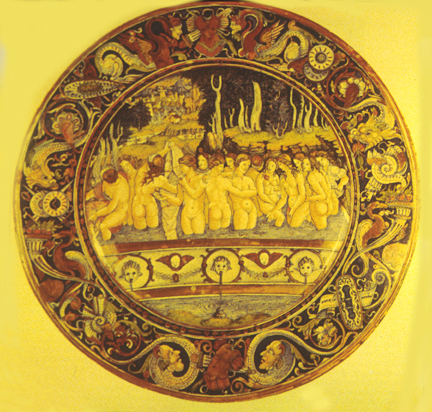By 1500, the majolica technique was firmly established in Italy, and regional centers of production, such as Deruta, had developed local and distinct indigenous styles. Most of the stylistic mannerisms copied from Hispano-Moresque lusterware had been cast aside in favor of local designs. The potters increasing technical skill and confidence is showcased in the painting of large plates, piatti da pompa, that treated the ceramic surface as a canvas on which to tell a story, and this style is called 'istoriato.' Bowls and plates were favorite forms on which to paint for obvious reasons, with the flared rims of the vessels illustrated to form a 'frame' around the central painting. The most common themes were mythological, allegorical, or religious imagery. The fashion of wealthy persons to commission large dishes to display on tables or sideboards encouraged potters to produce work under their patronage. The work of individual artists became collectible and potters such as Master Giorgio Andreoli, of Gubbio, became well known. Designs were often based directly on prints, drawings and paintings of more famous artists.
This was primarily due to the far reaching changes introduced between 1450 and 1500 CE by the mass availability of prints and engravings. This technological innovation of engraving meant potters had visual access to current and historical work in architecture, sculpture, and painting. Books from Northern Italy and Germany became sources of information. The image on this plate, for example, borrows quite directly from Raphael's 'The Three Graces.' The next image is a reproduction of that work, and Raphael's Three Graces can be clearly seen in the center of this plate, posed identically. The result of the mass availability of images to be 'copied' was an explosion of istoriato plate painting during the Italian Renaissance.

Istoriato Plate, Majolica with Luster, by Master Giorgio Andreoli
Castel Durante, 1525 CE, 17.5" d.


